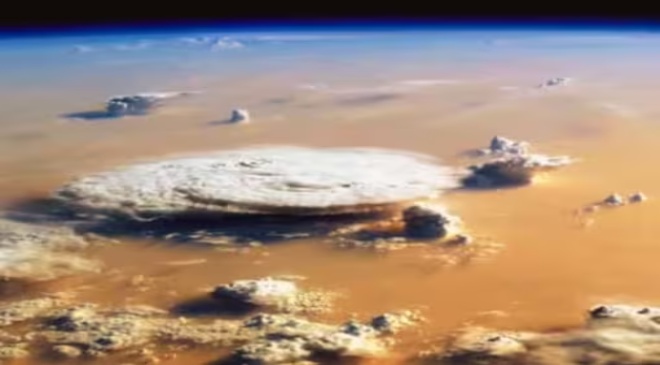Up until now, Earth is depicted as blue and green, so this particular scene might initially resemble Mars or Mercury.
What would various sights on Earth appear like when viewed from space? While not everything can be captured, we can certainly see a glimpse of the Sahara desert and its appearance from space. This footage has been recorded by the Johnson Space Center of the International Space Agency NASA.
Read More: Chocolate Day Turned ‘Bitter’ For Hyderabad Man Who Found ‘Live’ Worm in Cadbury Dairy Milk
In the viral video, large and small patches of white colour are visible on the light brown surface in certain areas. Up until now, Earth is depicted as blue and green, so this particular scene might initially resemble Mars or Mercury. However, this is a segment of Earth where the Sahara desert is located. The terrain consists of brown sand with scattered white clouds above it. The caption accompanying the video states, “This alien-looking planet is the Earth seen from space as sandstorms and cumulonimbus clouds cover the Sahara Desert“.
Read More: Hug Day Memes ‘Embrace’ Internet As Singles Continue to Hilariously Celebrate Valentine’s Week
This intriguing video has attracted the attention of thousands of viewers, with many leaving comments expressing their thoughts. One user pointed out the absence of the familiar blue colour, making it difficult to recognise Earth in such a setting. Some have even questioned the authenticity of the video, while others appreciate it as a captivating spectacle. Another user commented, “I find this view of the desert from space to be quite remarkable, offering a unique perspective on our planet’s diverse landscapes”.
Read More: Watch: Fishermen Release Dolphins They Caught Accidentally In Tamil Nadu
Last year, NASA reported that an ageing satellite, which had spent over a decade studying the sun, reentered Earth’s atmosphere over the Sahara Desert. NASA officials stated that they had not received any reports of damage or injuries resulting from the reentry, which took place during the early hours of the morning in Sudan.
The majority of the 660-pound (300-kilogram) satellite, named Rhessi, was predicted to disintegrate as it re-entered the atmosphere. However, experts anticipated that some fragments would survive the descent and impact the ground.
Launched in 2002, Rhessi ceased operations in 2018 due to a communication malfunction. Before its shutdown, the satellite was instrumental in studying solar flares and coronal mass ejections emitted by the sun. Rhessi stands for the Reuven Ramaty High Energy Solar Spectroscopic Imager.





































